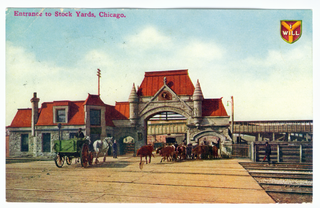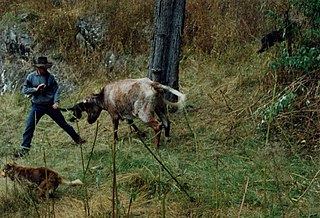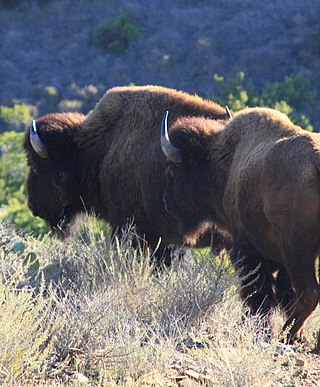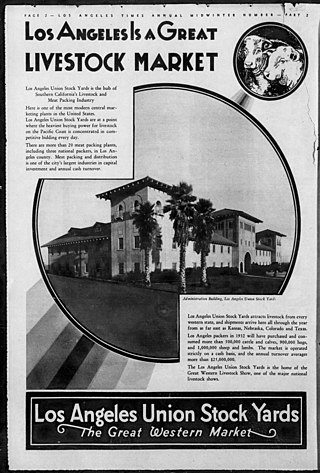
A cowboy is an animal herder who tends cattle on ranches in North America, traditionally on horseback, and often performs a multitude of other ranch-related tasks. The historic American cowboy of the late 19th century arose from the vaquero traditions of northern Mexico and became a figure of special significance and legend. A subtype, called a wrangler, specifically tends the horses used to work cattle. In addition to ranch work, some cowboys work for or participate in rodeos. Cowgirls, first defined as such in the late 19th century, had a less-well documented historical role, but in the modern world work at identical tasks and have obtained considerable respect for their achievements. Cattle handlers in many other parts of the world, particularly South America and Australia, perform work similar to the cowboy.

In railroad terminology, a stock car or cattle car is a type of rolling stock used for carrying livestock to market. A traditional stock car resembles a boxcar with louvered instead of solid car sides for the purpose of providing ventilation; stock cars can be single-level for large animals such as cattle or horses, or they can have two or three levels for smaller animals such as sheep, pigs, and poultry. Specialized types of stock cars have been built to haul live fish and shellfish and circus animals such as camels and elephants. Until the 1880s, when the Mather Stock Car Company and others introduced "more humane" stock cars, death rates could be quite high as the animals were hauled over long distances. Improved technology and faster shipping times have greatly reduced deaths.

The meat-packing industry handles the slaughtering, processing, packaging, and distribution of meat from animals such as cattle, pigs, sheep and other livestock. Poultry is generally not included. This greater part of the entire meat industry is primarily focused on producing meat for human consumption, but it also yields a variety of by-products including hides, dried blood, protein meals such as meat & bone meal, and, through the process of rendering, fats.

Gustavus Franklin Swift, Sr. was an American business executive. He founded a meat-packing empire in the Midwest during the late 19th century, over which he presided until his death. He is credited with the development of the first practical ice-cooled railroad car, which allowed his company to ship dressed meats to all parts of the country and abroad, ushering in the "era of cheap beef." Swift pioneered the use of animal by-products for the manufacture of soap, glue, fertilizer, various types of sundries, and even medical products.

The Fort Worth Stockyards is a historic district that is located in Fort Worth, Texas, north of the central business district. A 98-acre (40 ha) portion encompassing much of the district was listed on the National Register of Historic Places as Fort Worth Stockyards Historic District in 1976. It holds a former livestock market which operated under various owners from 1866.

The Grain Inspection, Packers and Stockyards Administration (GIPSA) was an agency of the United States Department of Agriculture that facilitates the marketing of livestock, poultry, meat, cereals, oilseeds, and related agricultural products, and promotes fair and competitive trading practices for the overall benefit of consumers and American agriculture. GIPSA was formed in 1994 through the joining of the Federal Grain Inspection Service and the Packers and Stockyards Administration.

The Union Stock Yard & Transit Co., or The Yards, was the meatpacking district in Chicago for more than a century, starting in 1865. The district was operated by a group of railroad companies that acquired marshland and turned it into a centralized processing area. By the 1890s, the railroad capital behind the Union Stockyards was Vanderbilt money. The Union Stockyards operated in the New City community area for 106 years, helping Chicago become known as the "hog butcher for the world," the center of the American meatpacking industry for decades. The yards became inspiration for literature, and social reform.

The Union Stock Yard Gate, located on Exchange Avenue at Peoria Street, was the entrance to the famous Union Stock Yards in Chicago. The gate was designed by Burnham and Root around 1875, and is the only significant structural element of the stock yards to survive. It was designated a National Historic Landmark in 1981. The plaza surrounding the gate also includes the city's principal memorial to its firefighters.

A muster (Au/NZ) or a roundup (US/Ca) is the process of gathering livestock. Musters usually involve cattle, sheep or horses, but may also include goats, camels, buffalo or other animals. Mustering may be conducted for a variety of reasons including routine livestock health checks and treatments, branding, shearing, lamb marking, sale, feeding and transport or droving to another location. Mustering is a long, difficult and sometimes dangerous job, especially on the vast Australian cattle stations of the Top End, 'The Falls' (gorge) country of the Great Dividing Range and the ranches of the western United States. The group of animals gathered in a muster is referred to as a "mob" in Australia and a "herd" in North America.
The National Western Stock Show is an annual livestock show and festival held every January at the National Western Complex in Denver, Colorado since 1906.

The Packers and Stockyards Act of 1921 regulates meatpacking, livestock dealers, market agencies, live poultry dealers, and swine contractors to prohibit unfair or deceptive practices, giving undue preferences, apportioning supply, manipulating prices, or creating a monopoly. It was enacted following the release in 1919 of the Report of the Federal Trade Commission on the meatpacking industry.

A pen is an enclosure for holding livestock. It may also perhaps be used as a term for an enclosure for other animals such as pets that are unwanted inside the house. The term describes types of enclosures that may confine one or many animals. Construction and terminology vary depending on the region of the world, purpose, animal species to be confined, local materials used and tradition. Pen or penning as a verb refers to the act of confining animals in an enclosure.

The Union Stockyards of Omaha, Nebraska, were founded in 1883 in South Omaha by the Union Stock Yards Company of Omaha. A fierce rival of Chicago's Union Stock Yards, the Omaha Union Stockyards were third in the United States for production by 1890. In 1947 they were second to Chicago in the world. Omaha overtook Chicago as the nation's largest livestock market and meat packing industry center in 1955, a title which it held onto until 1971. The 116-year-old institution closed in 1999. The Livestock Exchange Building was listed on the National Register of Historic Places in 1999.

The Livestock Exchange Building in Omaha, Nebraska, was built in 1926 at 4920 South 30 Street in South Omaha. It was designed as the centerpiece of the Union Stockyards by architect George Prinz and built by Peter Kiewit and Sons in the Romanesque revival and Northern Italian Renaissance Revival styles. In 1999 it was designated an Omaha Landmark and listed on the National Register of Historic Places. The Union Stockyards were closed in 1999, and the Livestock Exchange Building underwent an extensive renovation over the next several years.

Lamanda Park is a neighborhood in Pasadena, California. It is bordered roughly by Foothill Boulevard to the north, Del Mar Boulevard to the south, the Eaton Wash to the east, and Allen Avenue to the west, with a panhandle extending south along the western bank of the Eaton Wash. Like Annandale, it was originally a small township that was gradually enveloped by Pasadena. It was annexed in 1920. Even today, many commercial enterprises and newspapers still identify the area as a separate community.
National City was a suburb of East St. Louis, Illinois. Incorporated in 1907, it was a company town for the St. Louis National Stockyards Company. In 1996, the company, which owned all residential property in the town, evicted all of its residents. The following year, because it had no residents, National City was dissolved by court order. Its site was subsequently annexed by nearby Fairmont City, Illinois.

The Catalina Island bison herd is a small group of introduced American bison living on Catalina Island off the coast of Southern California. In 1924, several bison were acquired and, before the end of 1925, brought to Catalina. The bison are now quite popular with the tourists. Some buildings have been painted with images of bison and decorated with bison weather vanes. Over the decades, the bison herd numbered as many as 600. The population currently numbers approximately 100.

The Fort Worth Stock Show & Rodeo is the oldest continuously running livestock show and rodeo. It has been held annually in Fort Worth, Texas since 1896, traditionally in mid-January through early February. A non-profit organization, the Stock Show has provided millions of dollars in grants and scholarships in its tenure and continues to provide hundreds of thousands of dollars annually to assist the future leaders of agriculture and livestock management.
Ontario Stockyards is a livestock auction facility located in Cookstown, Ontario and serves much of Southern Ontario in selling cattle, pork and other livestock from producers to buyers to process as meat.

The Los Angeles Union Stock Yards were a livestock market and transfer station in the so-called Central Merchandising District south of downtown Los Angeles in Los Angeles County, California. The stock yards closed in 1960 and the facilities were demolished and replaced with other industrial warehouses.

















